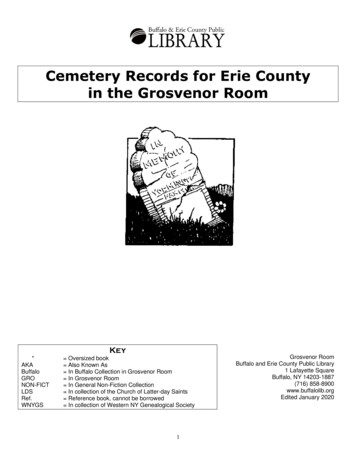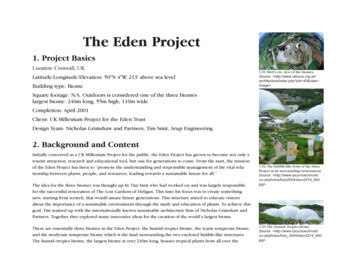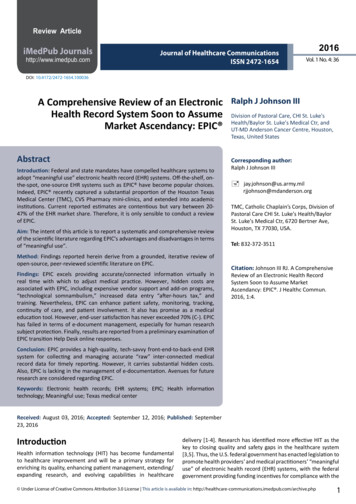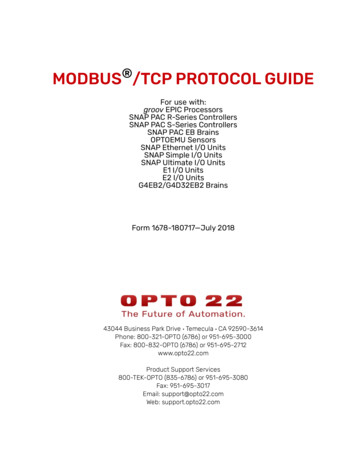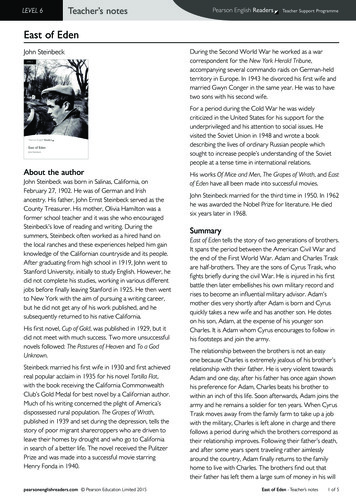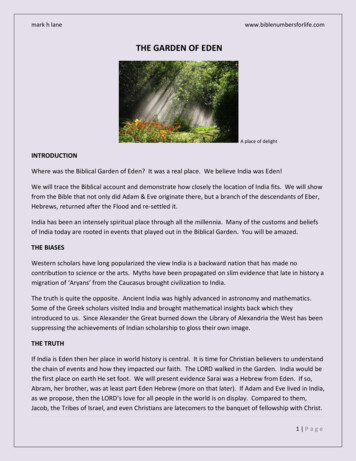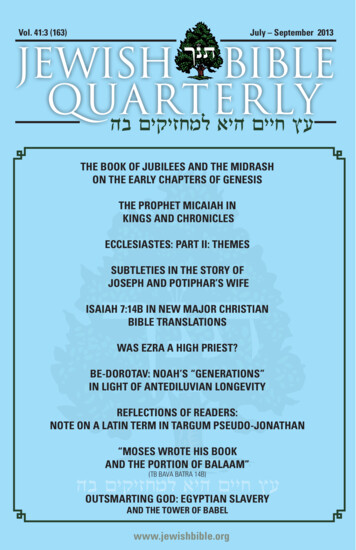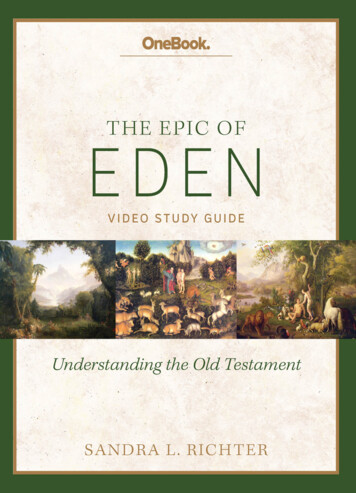
Transcription
THE EPIC OFEDENVIDEO STUDY GUIDE
This page intentionally left blank
OneBook.THE EPIC OFEDENVIDEO STUDY GUIDEUnderstanding the Old TestamentSANDRA L. RICHTERseedbed
Copyright 2014 by Sandra L. RichterAll rights reserved. No part of this publication may be reproduced, stored in a retrievalsystem, or transmitted, in any form or by any means—electronic, mechanical, photocopying,recording, or otherwise—without prior written permission, except for brief quotations incritical reviews or articles.All Scripture quotations, unless otherwise indicated, are taken from the Holy Bible,New International Version , NIV Copyright 1973, 1978, 1984, 2011 by Biblica, Inc. Used by permission. All rights reserved worldwide.Scripture quotations marked NASB are taken from the New American Standard Bible .Copyright 1960, 1962, 1968, 1971, 1972, 1973, 1975, 1977, 1995 by The Lockman Foundation.Used by permission.Printed in the United States of AmericaPaperback ISBN: 978-1-62824-131-0Mobi ISBN: 978-1-62824-132-7ePub ISBN: 978-1-62824-133-4uPDF ISBN: 978-1-62824-134-1DVD (3-disc set) ISBN: 978-1-62824-146-4Library of Congress Control Number: 2014945736Cover Design by Brushfire Design StudioPage design by PerfecType, Nashville, TennesseeSEEDBED PUBLISHINGFranklin, TennesseeSeedbed.comSOWING FOR A G REAT A WAKENING
To all the amazing people with whom I’ve had the privilegeof exploring the frontiers of the Great Story—my seminarians at Asbury Theological and Wesley Biblical;the good people of RCP fighting the good fight throughout the great state of California;the remarkably dedicated laypeople from Memphis to Marietta, Killearn to Jackson,Old Bethel to Boston, Lexington to Lubbock, Houston to Haverhill, Asheville to Southborough;and of course my undergrads at Wheaton—may this study serve to expand your borders, build the kingdom, and bring the exiles home.
This page intentionally left blank
CONTENTSPublisher’s ForewordAcknowledgmentsxixiiiWeek One: The Great Cultural Barrier / 3Day OneDay TwoDay ThreeDay FourDay Five79111315Week Two: Redemption / 17Day OneDay TwoDay ThreeDay FourDay Five2022242628Week Three: Real Time and Space / 31Day OneDay TwoDay ThreeDay FourDay Five3436384043
Week Four: Covenant / 47Day OneDay TwoDay ThreeDay FourDay Five5053555759Week Five: Treaty / 61Day OneDay TwoDay ThreeDay FourDay Five6668717375Week Six: God’s Original Intent / 79Day OneDay TwoDay ThreeDay FourDay Five8284868890Week Seven: God’s Final Intent / 93Day OneDay TwoDay ThreeDay FourDay Five9698100102104Week Eight: Noah / 107Day OneDay TwoDay ThreeDay FourDay Five110112114116118viii
Week Nine: Abraham / 121Day OneDay TwoDay ThreeDay FourDay Five124126128130132Week Ten: Moses / 135Day OneDay TwoDay ThreeDay FourDay Five138140143145148Week Eleven: David / 151Day OneDay TwoDay ThreeDay FourDay Five154157159161163Week Twelve: The New Covenant / 167Day OneDay TwoDay ThreeDay FourDay Five170172174176178Leader’s Session Guide / 183ix
This page intentionally left blank
PUBLISHER’S FO REW O RDWelcome to OneBook, the Bible study resource brought to you by Seedbed Publishing.In all of the history of the world, one book stands in a category of its own; one booktowers over them all. We’re referring, of course, to the Bible, the Word of God.Unparalleled in truth and unmatched in wisdom, the Bible tells us the story of theworld—from creation to new creation; it reveals the reality of God—Father, Son, and HolySpirit; and it teaches us what it means to be a human being, created in the image of God,broken by sin yet redeemed by grace, and destined for a life of profound purpose and deepmeaning.The Bible is worthy of our highest attention and deepest devotion. To be sure, it isa complex book—sixty-six books, written in three different languages, over the courseof fifteen hundred years, across three continents, by more than forty authors. It is in themarvel of such complexity that we discover the miracle of its simplicity: from beginning toend, Genesis to Revelation, the Bible tells a single, unified story.John Wesley famously said in the preface to his sermons,I am a spirit come from God, and returning to God: just hovering over the great gulf;till, a few moments hence, I am no more seen; I drop into an unchangeable eternity!I want to know one thing—the way to heaven; how to land safe on that happy shore.God himself has condescended to teach me the way. For this very end He came fromheaven. He hath written it down in a book. O give me that book! At any price, give methe book of God! I have it: here is knowledge enough for me. Let me be a man of onebook.We want to invite and inspire you to a lifelong study of the Bible. We want you tobecome a person of OneBook. We are determined to help you understand it and to read itfor all it’s worth so that you will be equipped to fulfill God’s purposes for your life. This isnot so much a book we seek to master as a book we seek to be mastered by.We have carefully chosen teachers, men and women, who have given their livesto understanding Scripture and in the process have stood under its teaching. We havesearched for people who love Jesus, who love the church, and who love others.I am pleased to present to you our first release in the OneBook Collection—The Epicof Eden Video Study Guide: Understanding the Old Testament by Dr. Sandra L. Richter.xi
The Epic of Eden Video Study Guide: Understandingthe Old TestamentThe Old Testament makes up three-fourths of the Bible—a clear majority—and yet it isthe least understood part of the Bible. Sandra Richter is one of the finest teachers of theOld Testament in the world. She has a way of teaching the Old Testament that brings it tolife. As a result of engaging with her in this study of the Old Testament, you will come to aprofound understanding of the New Testament and all that Scripture means for your life.She comprehends it from a deep place of faith and understanding and she has learned toteach it to ordinary people in extraordinary ways.Richter is a wife, a mother of two daughters, a Harvard-educated scholar, a teacher,and a passionate, Spirit-filled preacher of the gospel of Jesus Christ. She presently serveson the faculty of the esteemed Wheaton College in Illinois.You are in for a treat over the course of the next twelve weeks as you study the Wordof God together through this workbook and the video teaching sessions. It is our hopethat you and your Epic study group will be richly blessed by this investment of your time.Bright Came the Word From His MouthHear the music inspired by The Epic of EdenTwelve original songs written and performed by Matthew Clark.For more information visit matthewclark.netxii
ACKNOWLEDGMENTSThis epic study of the Old Testament could not have been completed without the colossalinvestment of many people. Our gratitude goes to J. D. Walt, the sower-in-chief of SeedbedPublishing, for having and holding the vision to make this happen. To Andrew Miller,director of publishing at Seedbed, for the nuts-and-bolts leadership necessary to any taskof this magnitude. To Ryan Staples for hours of filming and diligent (tedious!) editing ofthe DVDs. To Nick Perreault of Nikabrik Design for his commitment to detail in creatingsome amazing maps and charts (and always being willing to nudge Dothan just a littlefurther to the west). To Jason and Mary Aycock for our pedagogical template and the firstrun at the written guides. To Kathy Noftsinger for her dedicated, fastidious, and creativeinvestment in bringing the written guides and so much more to their current state of telos.To Don Swank, who indefatigably tracked down numerous images from ancient files andthe far reaches of the Internet. To Holly Jones for her masterful project management. ToMaren Kurek and Tammy Spurlock for their expert copy editing and proofreading skills.To Kristin Goble at PerfecType for her artful typesetting. To Matthew Clark, whose visionand heart have set this great story to music—music that he has so generously shared withus. To the studio audiences who courageously endured hours and hours of filming. ToTiffani Walt for her unending encouragement for this project and its team members. Andto every pastor and layperson who would not stop asking . . . our team is grateful to say thatThe Epic of Eden Video Study Guide: Understanding the Old Testament is at last available.Let the adventure begin!xiii
This page intentionally left blank
This page intentionally left blank
WEEK ONEThe Great Cultural BarrierA Word from the Author“The Bible is the saga of Yahweh and Adam, the prodigal son and his ever gracious heavenly father; humanity in their rebellion and God in his grace. This narrative begins withEden and does not conclude until the New Jerusalem is firmly in place. It is all one story.And if you are a believer, it is all your story. . . . If our goal is to know our own story, then wefirst have to come to understand the characters who populate the Old Testament: who theywere, where they lived, what was important to them” (Sandra L. Richter, The Epic of Eden:A Christian Entry into the Old Testament (Downers Grove: IVP Academic, 2008), 15, 17).IntroductionAn eight-year-old girl in the suburbs listens to her grandmother’s tale of growing up on a smallmidwestern farm; a ten-year-old boy listens while his grandfather tells of the time his father, anew immigrant, moved the family from an apartment in Brooklyn to a Craftsman bungalow inSan Francisco. In school, both of these children learn about the history of the United States—its founding, growth, and westward expansion; stories of war and peace, trial and triumph,of leaders great and small. Eventually these two become young adults, fall in love, and begintheir own new family. And two separate stories become one, which will, in turn, be passeddown to their children. All of these experiences and memories, individual and shared, becometheir story, shaping who they are and who or what they may one day become.What is your story?Most of us are like the two children mentioned above. Whether male or female,married or single, we’ve grown up with a common history, a common language, and a3
WEEK ONEcommon literature. We share common truths and legends, values and dreams, and wepass them on to the next generation. In short, we share a common culture. Each of us addsour personal narrative, weaving our thread into the fabric of society and thereby helpingto create the ever-expanding tapestry of culture. In doing so, the tapestry tells our collective story, one that we all know and share because our own hands had a part in creatingit. Our thread gives shape and substance to the whole just as the whole gives shape andsubstance to us.What is unique about the Christian community is that part of our story comes froma part of our “family” that we might not yet know: our forefathers in the faith—Abraham(who is known as Abram prior to his covenant with God), Isaac, and Jacob. This story isalso part of the fabric of our lives, and gives shape to who we were, who we are, and whowe will become.Real Time and SpaceThis week, we begin to address the barrier of culture that stands between us and this other“family.” As we learn about the culture of this other family, we will traverse the land of theBible from Mesopotamia to Canaan/Israel/Palestine to Egypt. We will travel in time fromAbraham’s world somewhere around 2000 BC to the Passion of Jesus in approximately AD 30.(Note: BC stands for the time period “before Christ” [or “before the Common Era”/BCE]and AD stands for the Latin Anno Domini, meaning “The Year of Our Lord” [also sometimesreferred to as the “Common Era”/CE].)As you journey through these stories, think about what it would be like to live in aculture where the family was the basic unit and regulatory force of society. Think about whatit would look like for God to connect with people living and breathing in this sort of tribalculture. With those thoughts in mind, let’s open the door and enter the epic story of the OldTestament!Humans, rather than recognizing the trappings of their ownculture (and that their culture may in fact be very differentfrom someone else’s), tend to assume that other societies arejust like their own. This is known as ethnocentrism and is ahuman perspective that is as old as the hills. (Richter, Epic, 21.)4
The Fertile Crescent
D DAYONEdFirst ContactBefore you open your Bible, jot down the names of seven characters from the OldTestament. If that took under a minute, go on to twelve, then twenty. With your Bible stillclosed, try to arrange these characters in chronological order. Next to each character listsome detail you know about them: an aspect of their story, their hometown, their spouse.If someone asked you why this person’s story was in the Bible, could you answer? Whatwould you say?Into the StoryRead Matthew 1. From the names in Jesus’ genealogy, circle any of the names that are familiar toyou. Place a check mark next to the names of those whose stories you could explain toa friend or child. Draw a question mark next to any of the characters whose stories disturb orconfuse you. Do you recognize characters here who are significant to Jesus’ genealogy? Can you guess why the New Testament writers would launch the first book of theNew Testament with a genealogy?7
WEEK ONEReal People, Real Places, Real FaithOut of the Old Testament characters on your list, identify one with whom you mostconnect. What parts of their story resonate with you? Now identify one character and/orstory that you find really challenging to accept or to understand. List both characters withyour reasons. What do you want to know about these characters? What doors or barriersstand between you and a clear understanding of them?Our People, Our Places, Our FaithHow would you respond if someone asked you today, “Why does the Old Testament(the backstory of the New Testament) matter to your Christian faith?” List some of yourresponses.8
D DAYTWOdFirst ContactImagine that you needed a new job. What are the first steps you would take? Who wouldyou ask for advice or direction? Where would you look and why? What are the five thingsthat would be most important for you to emphasize to a potential employer on your résumé?Into the StoryRead Genesis 29:1–30. Find aspects of this story that are culturally different from yours. Underline or listthem with their verse references. Are there differences here between their culture and yours that illicit a strongerreaction from you?Israelite society was enormously different fromcontemporary life in the urban West. Whereas modernWestern culture may be classified as urban and“bureaucratic,” Israel’s society was “traditional.” Morespecifically, it was “tribal.” (Richter, Epic, 25.)9
WEEK ONEReal People, Real Places, Real FaithIf you were Jacob, how would you react to Laban’s deception? Put yourself in Rachel’ssandals. How would you react to having the man promised to you given to someone else?Especially your older sister! Do you think Rachel was in love at this point? Consider Leah.How do you think she felt about being given in marriage to a man who wanted someoneelse? How in the world would these two women handle the wedding night? How in theworld would they handle their future relationship? What is your opinion of Laban at thispoint?My goal as regards the great barrier is to bring the heroes of the OldTestament into focus, such that you can see them as real people who lived inreal places and struggled with real faith, just as you do. We are “Abraham’soffspring” (Gal. 3:29 [NASB]), and his story is our story. (Richter, Epic, 17.)Our People, Our Places, Our FaithCompare the story of Jacob, Rachel, and Leah to your own story. Have you had any experiences similar to these characters? What significance do you see in the differences betweenyour story and this one? Are there other stories in the Bible where your inner child screams“That’s not fair!”? Perhaps the warfare techniques of the conquest in the book of Joshua orthe social position of women in the Old Testament? How could understanding the biblicalculture help you to better understand the Old Testament? Over the course of this study,your understanding of the time, space, and culture of the Old Testament story is goingto grow tremendously. The goal? Helping you understand your Old Testament better willhelp you understand your God and your other family better!10
D DAYTHREEdFirst ContactThink about who and what comprises your household. Who are the members? How manyare there? What is the pecking order in your household? Who (if anyone) is in chargeand of what? Who leads and how? How does your household structure compare to yourparents’, siblings’, friends’?Into the StoryRead Genesis 38. In Genesis 38:6, Judah marries Tamar to his firstborn, Er. According to Israel’spatrilocal culture, in whose household does Tamar reside? In Genesis 38:11, Tamar now lives in her biological father’s house. Why has shemoved? Do you find anything in this passage indicating that this departure was not thecultural norm? If so, what? What does Tamar do when she finds out where her father-in-law is? What actiondoes she take? What does Judah declare to be done when he learns that Tamar is pregnant?11
W E E K O NEAs we open the Bible, however, we find that the God of historyhas chosen to reveal himself through a specific human culture.To be more accurate, he chose to reveal himself in severalincarnations of the same culture. (Richter, Epic, 23.)Real People, Real Places, Real FaithDo you find that you are able to separate yourself from your own cultural norms as youread through Tamar’s story? Do you see Tamar as a real person in a real place in a realtime? In your mind, which characters/actions are good and which are bad? Why? List eachof the main characters and offer one word to describe each of those main characters.Our People, Our Places, Our FaithDo you ever find yourself avoiding certain Bible stories because they make you uncomfortable, disapproving of the things the characters are doing, or perhaps finding the scenariosare too violent? Have you ever noticed that a lot of children’s Bibles avoid these storiesas well? Throughout this study, we challenge you to stop dodging. Rather, thoughtfullyconsider the characters as real people who are quite human and fallen, in real places thatare probably geographically and culturally very different from your own, struggling withreal faith in real circumstances. The objective? To come out with a better understanding ofthe character of our God and a better understanding of his people past and present acrossthe globe.12
D DAYFOURdFirst ContactIf you were to write your last will and testament tonight, for whom would you make provision in the document? Who would be responsible for the care of your dependents? Whywould you make provisions for these persons and how would you go about choosing yourguardians?Into the StoryRead Deuteronomy 25:5–10 (known as the Levirate law). According to this Israelite law, “when brothers live together” (i.e. in extendedfamilies living under one roof), what responsibilities does a surviving brotherhave to his widowed sister-in-law? List each command. What do you think the intended outcome of this law might be? In the case of an injustice, what is the surviving wife instructed to do? What responsibilities belong to the community leaders?The people of Israel considered it a serious offense for a man to failto fulfill this responsibility to his dead brother. . . . Although thissystem seems very odd to most Westerners, it worked. The inheritanceof the deceased brother was properly conferred upon his legal offspring,and the young widow was secured within the household. Thus her currentneed for food and shelter was met, and her future need for a child to carefor her in her old age was addressed as well. (Richter, Epic, 31–32.)13
W E E K O NEReal People, Real Places, Real FaithIn the setting of the shaming described in Deuteronomy 25, what were the consequencesfor the brother who refused his responsibilities? What were the consequences for thewidow? How do you think these consequences affected the extended family?Our People, Our Places, Our FaithIn today’s world, would a widow in similar circumstances need help? Recast this womaninto a modern-day equivalent. To whom would such a woman turn for help? Who, if anyone,would be responsible for helping her? What would the community’s reaction be if she didnot receive help? Would it be different if it were a widower instead of a widow? Why?14
D DAYFIVEdFirst ContactHave you ever gone through the loss of a mentor or leader? Perhaps a boss who had madea big impact on your professional growth or a pastor who felt called to another ministry?Perhaps the premature death of a parent? What fears came with that transition? Whatlosses did you face? What words or actions did you find comforting?Into the StoryRead John 13:31–14:24. What is the setting of the narrative? What happened just before Jesus’ Passover meal with his disciples? Whathappened immediately following (John 18:1–5)? Focusing on 14:1–18, notice where familial or household language is used.Underline this language in your Bible. . . the scene is a private one—Jesus’ closest friends havegathered for one last meal together. Just after the meal,Jesus begins telling his disciples about his impending departureand the troubles that will follow. Of course, the disciples areconfused and upset. Peter asks the question on everyone’s heart:“Where are You going? . . . and can we go with you?”(John 13:36–37). (Richter, Epic, 39.)15
WEEK ONE Note verse 2 (NASB) in which Jesus says: “In My Father’s house are many dwellingplaces.” How does your Bible translate the phrase “dwelling places”? Checkseveral translations. Why do you think that Jesus speaks of his father’s house here?Real People, Real Places, Real FaithThink about being one of the disciples at the Last Supper. Jesus is telling you he is leaving,right at what should be the apex of the story. If you were Peter or James or John or Thomas,what would you be feeling right now? What would you ask Jesus?Our People, Our Places, Our FaithIf we want to know our God better, we’re going to need to understand his story better.Indeed, if the Bible is going to become our story, we’re going to have to put ourselvesback into the biblical characters’ time and space. As you wind down your study guide forthe week, ask yourself what steps you are willing to take over the course of this study toaccomplish that goal.16
WEEK TWORedemptionA Word from the Author“Our objective as Christians is to understand the story of redemption, the Bible. Morethan anything else, we want to hear the words of the biblical writers as they were intendedand to claim their epic saga as our own. To accomplish this, we need to get past the greatbarrier—that chasm of history, language, and culture that separates us from our heroes inthe faith” (Richter, Epic, 21).Real Time and SpaceLast week, we began to examine and inventory what we know about the characters andstories of the Old Testament—and more important, why it matters. We learned that the OldTestament is more than just an unfortunate prefaceto the New Testament, that it is an integral part ofpatriarchal: Having to do with theThe Story, and that it is our story. We began to crossauthority and centrality of the oldest livingthe great barrier by investigating Israel’s patriarchal,male member of a family in tribal society.patrilineal, and patrilocal culture.This week, we will continue to cross the culturalpatrilineal: Having to do with tracingbarrier by understanding what redemption meantancestral descent through the male line in ato the real people of the Old Testament. This weektribal society.we’re going to be all over our map, beginning inpatrilocal: Having to do with the livingMesopotamia in the city of Ur, and traveling to thespace of the family unit being built aroundland of Canaan/Israel/Palestine with Abraham andthe oldest male in a tribal society.17
WEEK TWOhis descendants in the Patriarchal Period. We will continue on through the period of Ruthduring the Settlement, to the time of Hosea during the Divided Monarchy, and finally tothe New Testament with Jesus and his disciples in Jerusalem. Take a moment to locate theplaces on the map as well as the time periods on the timeline on the following page.Abraham’s Migration into Canaan18
D DAYONEdFirst ContactIf you are married, how did you and your spouse meet? If you are not married, how didyour parents meet? After you got married, where did you/they live? Perhaps you/theycome from a culture in which marriages are arranged. Have you ever witnessed a clash ofcultures in your marriage or that of your parents? What has been your experience?Into the StoryWe begin this week with some review about ancient Israel’s patrilocal and patrilinealculture. Read Genesis 24:1–27, 50–67. What did Abraham ask his servant to swear he would and would not do? Why was the servant not to take Isaac back to Abraham’s homeland? What was the relationship between Nahor (Rebekah’s grandfather) and Abraham? After Abraham’s servant recounts his mission and his story, how do Laban(Rebekah’s brother) and Bethuel (Rebekah’s father) respond? What was Rebekah’s response? Does her response surprise you? What aspects of ancient Israelite culture (as opposed to your native culture) doyou observe in this story?20
DAY ONEReal People, Real Places, Real FaithIn the biblical account, it appears that Rebekah did not hesitate to say “yes” to Abraham’sservant and thereby agree to be Isaac’s wife. Put yourself in Rebekah’s world for a moment.How old do you imagine Rebekah was? What does she agree to leave? What does she gain?If you were Rebekah’s mother or her little sister, what emotions would you be feeling rightnow? Write down some of your thoughts.Our People, Our Places, Our FaithIn our own cultures, the story of Rebekah may seem strange. Arranged marriages andfamily compounds with fifteen to thirty family members are certainly not the norm inthe West! It is sometimes easy for us to be critical of cultures that are different from ourown. In an attempt to understand the ancient Israelites, and therefore better understandwhat the biblical writers are communicating, jot down three things that you see as positiveaspects of Israelite culture involving marriage.21
D DAYTWOdFirst ContactWhat is your position in your family’s birth order? Are you the oldest, youngest, middle,or perhaps fifth out of eight? If you are a firstborn, what types of privileges and responsibilities were unique to you in your family? If you are not a firstborn, what sorts of uniqueprivileges did you see your oldest sibling receiving from your parents? How did you feelabout that at the time? How do you feel about it now?Into the StoryRead Deuteronomy 21:15–17 and Genesis 25:19–34. According to the law found in Deuteronomy, what does the firstborn son receiveas his inheritance? Why do you think that is? To whom did Rebekah give birth? Who was the firstborn, and therefore the one to whom the birthright was due? For what did he exchange his birthright and why? In Jacob and Esau’s patrilineal culture, what implications did the switching of thebirthright have? Where is Rebekah in this mix? Where is Isaac?22
DAY TWOReal People, Real Places, Real FaithThe biblical author tells us that Esau was famished, so much so that he chose food overhis double-portioned inheritance. Thinking about Israel’s tribal culture and the privilegedposition of the firstborn male, how do you think Esau felt after he realized the implicationsof his choice? How do you think his father felt about his choice?Our People, Our Places, Our FaithIf you know the rest of the story of Esau and Jacob, you know that Jacob becomes thefather of twelve sons who become known as the twelve tribes of Israel. One of those tribesis Judah, from whose line Jesus comes. In a tribal culture in which the norm was that theeldest son was the one to lead the family, God, in opposition to that cultural norm, haschosen the younger son to lead. What does this tell you about God’s character and hisways? Do you think God felt constrained to operate according to Jacob’s deceit? Or do youthink God was free to do and choose as he wished?23
D DAYTHREEdFirst ContactWhen did you leave home (i.e., your “father’s house”)? What was the catalyst for the move?Was it school, military service, marriage, a family breakdown of some sort? When didyou establish your new household? What were the economics of that move? Does yourcurrent household continue to interact with your extended family (parents, grandparents,siblings, aunts, uncles, and cousins)? If so, when and how? How does your householdstory compare to that of other people you know?Into the StoryRead Genesis 11:27–12:5; 13:1–14:16. Who belonged to Abram’s bêt ’āb (“father’s house[hold]”) in Genesis 11? Who is the patriarch? Where does Lot fit into that mix? Complete the family tree below to show the relationships.NahorTerah24
DAY TH REE How does the household change in Genesis 12:5? What is the catalyst for thischange? How does this household change again in chapter 13? What is the catalyst for thechange this time? Who are the heads of the householdsnow? What crisis occurs in Genesis 14:9–16? In the crisis of chapter 14, who is theenemy and what has he taken? In this crisis, what did Abram bring to thefight? How does your understanding of bêt ’āband the tribal structure of the society affect your understanding of this narrative? Did you glean anything that you may not have noticed in previous readings?When the patriarch died, or when thebêt ’āb became too large to sustain itself,the household would split into new households,each headed by the now-oldest living malefamily member. (Richter, Epic, 27.)Real People, Real Places, Real Faith
The Epic of Eden Video Study Guide: Understanding the Old Testament The Old Testament makes up three-fourths of the Bible—a clear majority—and yet it is the least understood part of the Bible. Sandra Richter is one of the finest teachers of the Old Testament in the world. She has a way of teaching t

